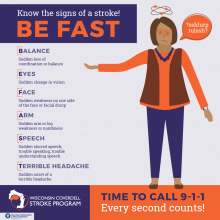The Chronic Disease Prevention Program (CDPP) is an integral part of the Wisconsin Department of Health Services (DHS), housed in the Division of Public Health and the Bureau of Community Health Promotion. In addition to the base funding and support we receive from DHS, we also receive funding and support through cooperative agreements from the Centers for Disease Control and Prevention (CDC) and other organizations.
What we do and why we do it
We want everyone in Wisconsin to live their best life. The prevalence of chronic disease and health inequities threaten this vision. Why? Chronic diseases are common, costly, and can be deadly, especially without adequate treatment. Studies have shown that effective prevention can completely avoid or delay many chronic diseases, limiting their negative impact. In addition, people who already have these conditions can benefit from increased access to care, help with managing symptoms, and more.
All health is connected, meaning that having one chronic disease often means developing additional conditions. That also means that methods to help prevent or adequately treat patients with conditions such as type 2 diabetes can also improve patients' brain health (PDF) and potentially lower their risks of developing conditions such as Alzheimer’s disease.
To help address these issues, we work hard to address environments, systems, and health behaviors that are associated with key chronic diseases and precursors. Our program's impact spans all ages and across multiple settings, including health care, local community, early care and education, schools, and work sites.
Chronic disease is greatly influenced by social determinants of health, or the social, economic and physical conditions in the environment in which people are born, live, learn, play, work and age. As an example, the prevalence of conditions such as heart disease, stroke, and diabetes is higher among people with lower incomes and education levels. We also know that, due to systemic oppression, such as racism, people who are forcibly marginalized, such as Black, brown, Indigenous, and other people of color, often fall into higher risk categories. When we add in data around how the stressors that come along with discrimination can affect the body, it shows us an increase in risk from both the systems and people that engage in discrimination.
We utilize data and tools to find populations that, due to systems of oppression, are disproportionately affected by chronic diseases and related risks such as high blood pressure. We can then work with groups and/or members of these communities to tailor messaging and interventions to reach these populations in a culturally competent manner.
Through the creation and maintenance of partnerships across Wisconsin, we can coordinate effective work to increase prevention efforts, improve access to care, and more. This also helps us to be mindful of the ways that culture, location, and region can all impact health. Examples of partners include local city- or county-level health departments, coalitions, organizations, community members, and more.
CDPP Partner Request for Interest Survey
Are you interested in working with CDPP on the Centers for Disease Control and Prevention (CDC) Chronic Disease Notice of Funding Opportunities (NOFOs) to be released in early 2023? Please complete the Request for Interest survey by December 30, 2022. Additionally, a PDF version of the survey is available as a reference (not to be submitted).
Latest publications

The Wisconsin Physical Activity and Nutrition Road Map (P-03170) serves as a starting point to understand key data, community needs, evidence-based strategies, and infrastructure needed to implement equitable physical activity and nutrition initiatives statewide. The Road Map is intended to serve and support Wisconsin communities and their efforts to create healthier places and spaces that center equity and support optimal health.
Training and continuing education
Featured professional resources

The Team-Based Care Tool (P-03162) and the Self-Measured Blood Pressure Tool (P-03163) are planning resources for Wisconsin health systems and clinics. The tools guide health system and clinic staff through project planning, implementation, and evaluation.
 Want to make your workplace healthier? Check out our updated Worksite Wellness Kit to start making a difference in your employees' health today!
Want to make your workplace healthier? Check out our updated Worksite Wellness Kit to start making a difference in your employees' health today!
Heard of BE FAST Bella? She's your newest asset in promoting stroke awareness.
Archived webinars and newsletters
Connect with local coalitions
Related programs
Focus areas
Heart disease

Heart disease refers to conditions that affect the way the heart functions including blood flow to it.
The CDPP partners with communities, health systems, health care providers, insurers, and professional organizations to improve heart disease prevention and management.
Select a topic below to explore our current projects and partnerships. Initiatives include:
- The Wisconsin Heart Health Alliance.
- The Wisconsin Heart Health Community of Practice.
- Cardiac rehabilitation.
- Medication therapy management.
- Team-based care.
The Coverdell Stroke Program

With funding from the CDC, the CDPP works with hospitals, emergency medical services (EMS), and professional organizations across the state to support a healthier Wisconsin by improving the community awareness and the quality of stroke care. The CDPP manages several projects to enhance coordinated systems of care, promote clinical best practices, and support patient self-care and health literacy. The goals of Wisconsin’s Coverdell stroke program are to:
- Measure, track, and improve the quality of care for all acute stroke patients.
- Increase public awareness of stroke treatment and prevention.
- Through secondary prevention, decrease the rate of premature death and disability from acute stroke.
- Reduce disparities in acute stroke care by providing underserved populations with better access to high-quality care.
Diabetes

Diabetes affects how your body turns food into energy. Most of what we eat is broken down into sugar (or glucose) and enters our bloodstream. The pancreas makes a hormone called insulin that lets blood sugar into our cells for energy. If you have a form of diabetes, your either body doesn't make enough insulin or can't use available insulin as well as it should. When this happens, too much blood sugar stays in your bloodstream, which can lead to serious health problems. Here are the most common types of diabetes:
Type 1 diabetes is caused by an autoimmune reaction (where the body attacks itself by mistake) so insulin isn't made anymore. About 5% of people with diabetes have type 1. Type 1 is most often seen in children and young adults.
Gestational diabetes develops in pregnant women who have never had diabetes before. Every year, 2% to 10% of pregnancies are affected by gestational diabetes. If you have gestational diabetes, it usually goes away after your baby is born, but greatly increases your risk and your baby's risk of having type 2 diabetes later in life.
Prediabetes occurs when blood sugar levels are high, but not high enough to be considered type 2 diabetes yet. About one-third of adults have prediabetes, but most don't know it. You can have it for years without symptoms, so it often goes undetected until it becomes type 2. You can find out if you're at risk by taking the one-minute risk test.
Type 2 diabetes occurs when your body doesn't use insulin well. It can lead to serious health problems like heart attack, stroke, blindness, kidney failure, and loss of toes, feet, or legs. Two out of five adults are expected to develop type 2 diabetes in their lifetime.
Nutrition and physical activity

The Nutrition, Physical Activity and Obesity Program works in a variety of settings to provide resources that can be used locally. Through materials and training workshops, the program emphasizes changing the setting environment to provide access and opportunities for people to eat well and be active. Primary settings include communities, early care and education, schools, and work sites.
The program also works with statewide partners to coordinate efforts for more impact. Partners include other state agencies, key statewide organizations, and local coalitions.
Are you a health system looking to partner with us?
Contact the Chronic Disease Prevention Program staff today to see how we can work together to improve the health of Wisconsinites.


